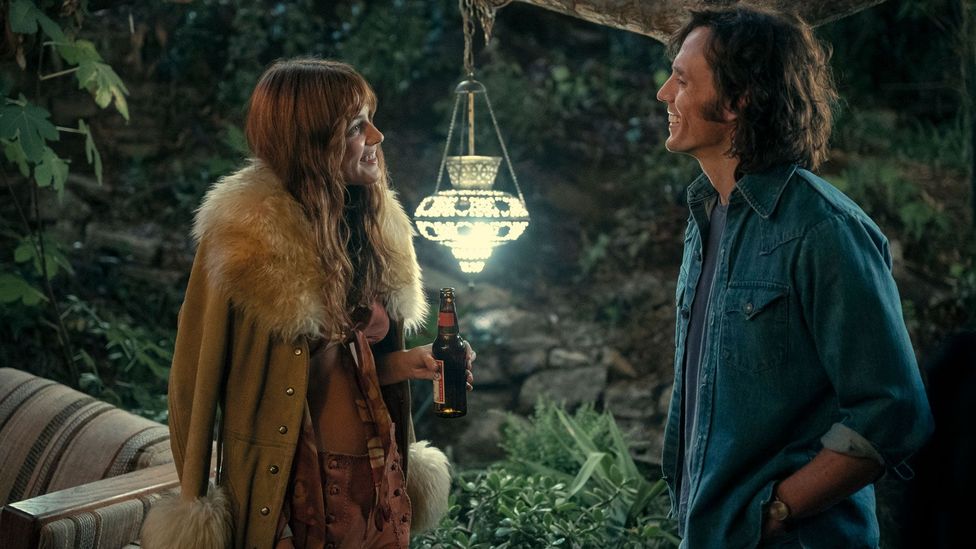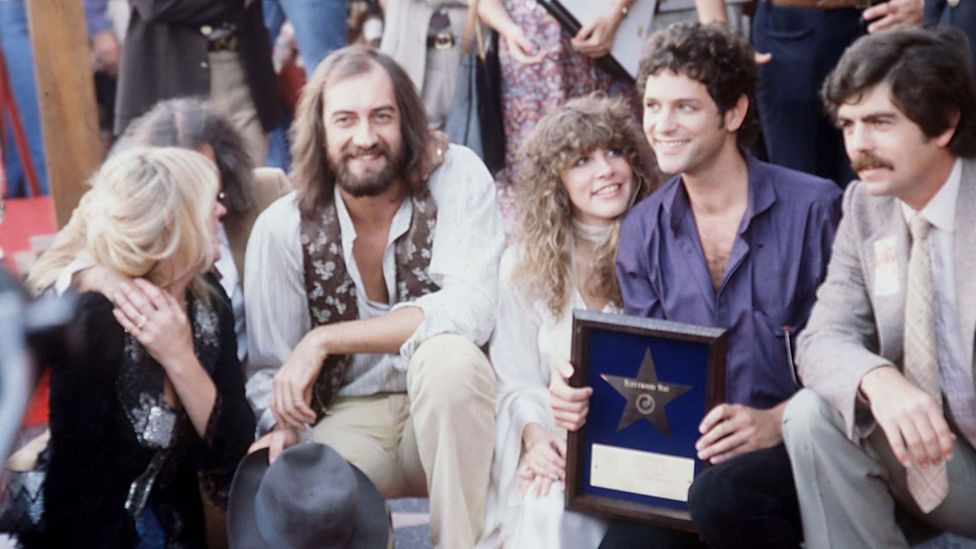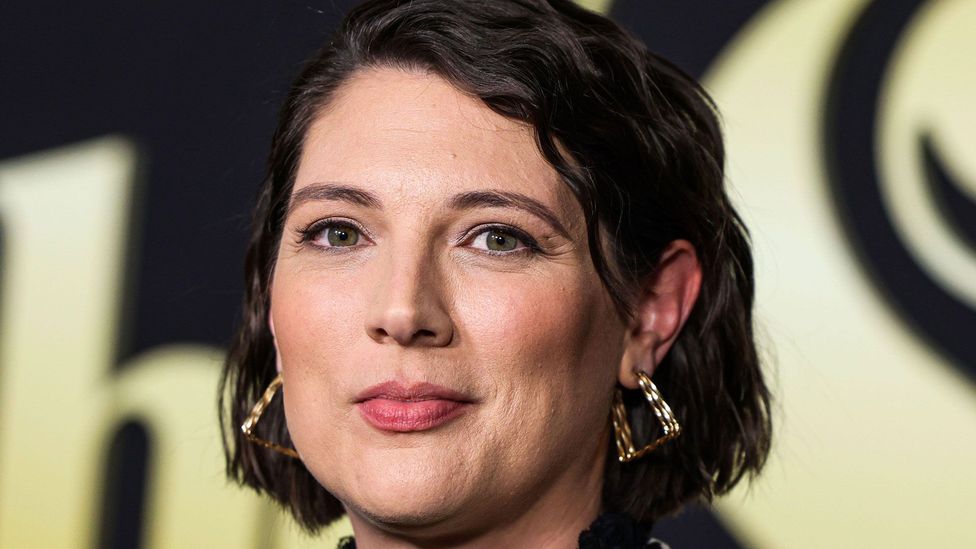They say if you can remember the 60s then you weren’t really there, but arguably, that adage is even more fitting for the 70s. From the glamorous debauchery of disco in Studio 54 to the anarchic fever of punk, hedonistic excess hit new heights. Given that, older music fans might think they’ve simply forgotten about the best-selling band of that hazy decade, Daisy Jones & The Six. With the group’s seminal album, Aurora, now available internationally, and with an accompanying bio-series about why the group broke up currently running on Amazon Prime Video, you could be wondering: who are they, again?
More like this:
– 11 TV shows to watch this March
– The anthemic power of Edge of Seventeen
– Why 1971 was an extraordinary year in film
In fact, the band has never existed. It is a fantastical figment of the imagination of author Taylor Jenkins Reid in her novel Daisy Jones & The Six. The book – published in 2019 – tells the origin story of the fictional band, and its members: the titular frontwoman Daisy Jones, co-lead singer Billy and his lead guitarist brother Graham Dunne, keyboardist Karen, rhythm guitarist Eddie and drummer Warren (as well as Billy’s wife, Camila) against the backdrop of LA in the 70s. It covers the in-band love affairs and bitter rivalries that ensued, the high-living, pleasure-seeking and addiction – and, of course, the creation of their music, which documented all their drama.

Daisy Jones & The Six tells the story of a 70s chart-topping band riven by inter-group love affairs, rivalries and addiction (Credit: Amazon Prime Video)
The novel, like the fictional band, became an instant sensation. The it-book of 2019, it has sold more than one million copies worldwide, spent nine weeks on the New York Times bestseller chart, and been a hit on BookTok. It has captured the imagination of readers, among other things, for its escapist qualities, as they are happily transported back to a time of rock ‘n’ roll excess, played out in sun-kissed, bohemian 70s California. Now, the new 10-part small-screen adaptation, which premiered its first three episodes a couple of weeks ago and has been rolling out further episodes weekly, may prove similarly alluring to Amazon Prime viewers; from the opening beats, it is captivating. If reading the book made you feel like you were there, the TV series draws fans even further into the action, bringing viewers along for the wild ride of the band’s genesis, and keeping them hooked until the fateful last gig when the group implodes.
The book’s power
Among those who consider the book a personal favourite are author and host of the You’re Booked podcast, Daisy Buchanan. “I was lucky enough to read an early copy – and even before it came out, I could feel the buzz,” she tells BBC Culture. “I read it from cover to cover on a train journey, and I was completely captivated. You know something’s great when you’re so consumed by the reading experience that you don’t want to pick up your phone.
“The story is filled with sharp, clear, compelling voices – not just Daisy’s. I love Karen, the band member whose personal turmoil – and love story – is brewing quietly in the background. I think the secret to great storytelling is writing characters that readers want to spend time with. Taylor Jenkins Reid makes you want to spend every spare second hanging out with the band.”
What sets the novel apart from other music-themed novels – like Roddy Doyle’s The Commitments or Utopia Avenue by David Mitchell, for example – is its format. Told in an unusual oral history style, it blurs the boundaries between reality and fiction. Made up of mock interviews with the different band members and their associates, it immerses the reader fully in its made-up history, as well as adding narrative tension by having the band’s “true” story disputed by the different characters. As the fictional author of the oral history declares at the beginning of the novel: “It should be noted that, on matters both big and small, sometimes accounts of the same event differ. The truth often lies, unclaimed, in the middle.”
“There’s a real feeling of urgency, [the testimonies] a cross between gossip and confession,” says Buchanan, explaining what made many people race through the book so hungrily. As Reese Witherspoon, who made the novel part of her book club, then successfully bid to make the TV adaptation via her production company, Hello Sunshine, said at the time of its release: “I devoured Daisy Jones & The Six in a day, falling head over heels for it. Daisy and the band captured my heart.”
For the author, Jenkins Reid, it was her sixth novel, following up her 2017 work The Seven Husbands of Evelyn Hugo (which is currently also being adapted for TV by Netflix). She has got a few ideas as to what made Daisy Jones & the Six such a soaraway success: “It’s always hard for me to conjecture about what I might have done right, but I think I’m always trying to tell stories that are really compelling to me in two different ways,” she tells BBC Culture. “One, that they have something to say: and I’m really proud of what this book – and what this TV adaptation – has to say about women in rock, and how they make their way in the world. The other thing that’s important to me is to be fun. I want to make stories that are fun to read.”
The Fleetwood Mac connection
When it came to wild-living musical inspiration, Jenkins Reid needed to look no further than Fleetwood Mac as a starting point. Fleetwood Mac were one of the bestselling acts of the 70s, and the eventful history around the making of their 1977 iconic album, Rumours, is well-documented. At the point of going into the recording studio, two couples in the band – Stevie Nicks and Lindsey Buckingham and Christine and John McVie – had split up and were having affairs with other people, fuelling the heart-breaking or angry emotions that the musicians channelled into songs about their ex-partners.

The torrid drama around Fleetwood Mac, particularly during the making of their 1977 album Rumours, is a clear inspiration for Daisy Jones & The Six (Credit: Alamy)
Jenkins Reid has explained in the past that the first kernel of the idea for Daisy Jones came from her memory of watching footage of Stevie Nicks performing the song Landslide, from their 1975 album Fleetwood Mac, while Buckingham watched on intently. “It looked so much like two people in love. And yet, we’ll never truly know what lived between them,” she said. “I wanted to write a story about that, about how the lines between real life and performance can get blurred, about how singing about old wounds might keep them fresh.”
Of course, the story of Fleetwood Mac can’t be told without mentioning their drug habits. Par for the course in the LA music scene in the industry at that time was the use of cocaine and other illegal substances – Mick Fleetwood once claimed the amount of cocaine he’d snorted in this era would stretch to a line seven miles long, while Stevie Nicks has spoken extensively about her own drug addiction, which escalated as the band rose to global success. The character of Daisy Jones is obviously strongly indebted to the frontwoman of Fleetwood Mac; from her wild-child behaviour to her cosmic sensibility, and ethereal, tasselled and floaty stagewear. Readers follow Daisy’s journey from recreational substance abuse to dangerous addiction – something which bonds her with her married bandmate, Billy, also an addict struggling with sobriety, with whom she engages in a tormented, emotional love affair.
Meanwhile, the character of Karen, the straight-talking, effortlessly cool British keyboard player in the band, is almost a double for the late Christine McVie. This enmeshing of a fictional band with the much-loved Fleetwood Mac – of whom there has never been a definitive biopic – is another key factor in the appeal of the book, and now the TV series, says Buchanan. “It’s a very good cultural crossover. I know a lot of women who really love Fleetwood Mac, possibly because – unlike so much of the music of the era – there actually are women in Fleetwood Mac. I love Daisy and Karen like I love Stevie Nicks and Christine McVie.”
However, while Fleetwood Mac seems to be a blueprint for Daisy Jones & The Six – and there are many striking parallels – Jenkins Reid explains that she sees their history as more of a backdrop to her tale: “To me, this isn’t a story about Fleetwood Mac. It’s fiction and there’s nothing that happens in the story that really happened to Fleetwood Mac in any concrete or specific way. It’s just about vibes, Fleetwood Mac vibes. But in creating that sense, we were able to tell a very different story.”
“I think that any time you write a story about the 70s there’s going to be inspiration pulled from Fleetwood Mac,” adds executive producer Brad Mendelsohn. “But it’s also Linda Rondstadt, Tom Petty, Bruce Springsteen, all of those people who were inspiration for Taylor and the writers on the show.”
Getting the music right
One of the biggest challenges for the creative team adapting the series was finding the right actors to create a bona-fide band, and then furnishing them with original songs that convincingly sounded like they could have been chart-toppingly sensational, compelling audiences of thousands to sing along with every word. However, Jenkins Reid says that this wasn’t an issue for her personally: for while she wrote lyrics to all the songs of the fictional album Aurora in her book, these weren’t used in the series, and instead the challenge of devising the music was laid firmly at the door of the production team, including the series co-creator Scott Neustadter. As Jenkins Reid puts it: “I remember having a conversation with one of the execs at Amazon, who said, ‘So now we just have to go and make the best-selling album of the ’70s?’. And I was like, ‘For once, that’s not my problem!'” she laughs. “‘That feels like a really ambitious task and I’m glad it’s not assigned to me’.” Neustadter agrees with her about the mission they had on their hands: “It’s true, the way you describe Aurora [in the book], there are some very intimidating adjectives.”
With Jenkins Reid happily relinquishing control over the music, it meant the producers could pull together a crack team, explains Mendelsohn: “Taylor set the bar incredibly high, based on this being the biggest band of that time period, so we knew we had to hire people at the top of their game. Blake Mills [songwriter and producer for the likes of John Legend and Jack Johnson] came up early and often, and then people like [fellow producer] Tony Berg were able to reach out to other incredible musicians like Jackson Browne, Phoebe Bridgers, Marcus Mumford and many others.” Sonic Youth musician Kim Gordon was also brought in as a creative consultant.

Author Taylor Jenkins Reid currently has another one of her bestselling books, The Seven Husbands of Evelyn Hugo, being adapted for TV (Credit: Amazon Prime Video)
There is a slight cognitive dissonance in the first few episodes of Daisy Jones & The Six, for when the band start to play, the viewer naturally expects to hear a familiar song, perhaps even a Fleetwood Mac number (there is a needle-drop of Rumours track Gold Dust Woman eventually used with poignancy in a pivotal moment towards the end of the series). But the repeated use of original songs like Regret Me and Look At Us Now (Honeycomb) mean that by the end of the series, the songs are seared into the viewer’s memory. Which, fortuitously, is a good tie in with the fact that band’s album, Aurora, was released on Atlantic Records, on the same day the first three episodes premiered.
Is it weird seeing a band you’ve imagined as a fictional construct then come into actual being? “It’s the coolest thing ever,” says Jenkins Reid. “I love mythologising a band, if I could do it 17 more times I would. I absolutely love it, it’s been the joy of my career to find this little pocket of storytelling. To now see that something I made up is now standing in front of me, I compare it to a 3D-printer that’s attached to my brain that’s now made it real. It’s incredibly, incredibly gratifying.”
Much of the credit for how authentic the band feels on screen can be handed to the actors, including Riley Keough as Daisy Jones, Sam Claflin as Billy, and Suki Waterhouse, Will Harrison, Josh Whitehouse and Sebastian Chacon on stage as their various bandmates. “Every sound you hear coming out of their mouth is all theirs,” Mendelsohn explains. “Riley put in an insane amount of work and training.” Despite Keough being Elvis’s grand-daughter, “she had never sung before,” he adds. “When we cast her [it was] simply because of her extraordinary talent.
“When Riley came into audition, it was a transformative moment for all of us for the series. She was our Daisy – there was not another actor that we considered. Once we had Riley, we needed someone who could be her equal, and when we met Sam, similar to Riley, we were blown away. He embodied Billy – soulful, powerful. When the two of them had a chemistry read, there was just electricity and we knew we had a really great match between them.”
The enforced downtime of the pandemic meant the actors had longer to train and hone their musical skills and voices, and the result is a band, that, to all intents and purposes, could have been that genre-defining, chart-topping outfit so enthrallingly imagined by Jenkins Reid on the page.
As the series concludes over the next couple of weeks, what remains to be seen is quite how high this semi-fictional-semi-real band can fly. Could the album Aurora hit the upper echelons of the charts, and might a stadium live tour even follow? When asked during the press launch of the series whether they would go on tour, the actors were coy. “We might,” said Keough, while Claflin said: “I hope so… I’d love to. It would be a huge bonus for us to have the opportunity to come together and play again in whatever capacity. We’ll do small venues, birthday parties, bar mitzvahs… whatever!”